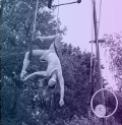Festival de Mujeres en Escena Por La Paz Bogota, Colombia 2012
Festival de Mujeres en Escena Por La Paz
(Women on Stage for Peace Festival)
Bogotá, Colombia November – December 2012
It’s midnight Tuesday, November 27, 2012. My stage manager/ lighting designer, Sarah Harris, and I have flown from JFK to Bogotá airport. We pass through customs and receive a very warm welcome from German Moure. German and I worked together in the Bread and Puppet Theater from 1967 to 1969. We haven’t seen each other since then. He’s now an 80-year-old director and beloved theater professor at Teatro Libre, a theater academy that he helped found.
German helps us find Mauricio, the representative from the Women on Stage for Peace Festival who is assigned to get us settled. He drives Sarah and me to Tip Top, a family-run hostel in La Candelaria the oldest neighborhood in Bogotá. The winding streets of La Candelaria are mostly deserted at this time of night, but we can already see evidence of its full creative spirit. We settle into our rooms for the night, a feeling of anticipation and excitement shared between us, not quite sure what the next week will bring.
In early 2012, German Jaramillo, a Colombian director of Latin American plays presented by Theater for the New City in New York, told me about Festival de Mujeres en Escena. (Women on Stage Festival.) It’s the women’s theater festival in Bogotá organized by the extraordinary actress, writer, director, political activist and grandmother, Patricia Ariza. In 1966, she co-founded Bogotá’s radical Teatro La Candelaria with the brilliant director Santiago Garcia. I was already familiar with their work. In 1968, Peter Schumann and I saw one of their shows at the Nancy, France International Experimental Theatre Festival, the same festival that rocketed Bread & Puppet to international fame. Teatro La Candelaria performed a great and memorable show. B&P loved their work and they loved ours. Patricia herself has been called “one of the country’s best-known public artist-activists” (Colombia’s National Audiences by Adam S. Horowitz). The prospect of working with such an influential and inspiring woman seemed like a wonderful opportunity. So, imagine my excitement when, at the beginning of November 2012, Patricia officially invited me to be a part of this year’s festival, which was slated for November 20 – December 15 with 69 performances at 19 venues in Bogotá, including an outdoor show at the Plaza Bolivar. I was the only performer invited from the USA. Most of the other 40 companies came from different regions in Colombia. There was also a company from Ecuador, Canada, Spain, and Cuba. The festival offered workshops in dance, voice, song, the musicality of the body and individual and collective creation.
I decided to perform my solo drama, WHAT DO I KNOW ABOUT WAR? The show is sa Theater for the New City presentation. It’s based on the words of American troops who have served in Iraq and interviews with their families. I portray 12 real-life characters from two 19-year-old girls who leave home for the first time to serve in Iraq and are killed in battle, to a National Guardsman who becomes a conscientious objector in the wake of Abu Ghraib. The New York Times hailed the show as…“Brilliant…surreal…like eavesdropping on a small, sorrowful town. A one-woman show that puts a face to the words of soldiers in the Iraq war.” Theater for the New City presented the show in New York. I subsequently toured the US and performed at the 20th Cairo International Festival of Experimental Theatre, the American University in Cairo and at the 6th “Maria” International Festival of One-Woman Shows in Kiev, Ukraine.
Despite Colombia’s decades-long history of violence, it has one of the most active cultural ministries in Latin America, a national theater law, and a strong artistic community. Patricia Ariza and Teatro La Candelaria have contributed in no small part to this wonderful theater history. In fact, Patricia and Santiago spearheaded collective creation as a form of theater making throughout Latin America. Since 1994, Patricia has organized 17 Women’s Theater Festivals on a shoestring. Since 2002, she has also organized an International Alternative Theater Festival that complements Bogotá’s Festival Ibero-Americano, the biggest international theater festival in the world. Patricia’s festivals, while working with smaller budgets, are focused on activism and freedom of expression. When asked how she does it, Patricia responded, “with rage… rage, coupled with an unrelenting social commitment, and a loyal public base” (Horowitz). Patricia is resourceful and dedicated to using theater as a tool for combating violence and injustice. She is not afraid even though her life has been threatened. If anything, it pushes her to fight harder.
Now, after fifty years of unspeakable violence, the Colombian government and the largest guerilla group, FARC, have agreed to sit down and talk peace. In celebration, this year’s Mujeres en Escena Festival has been dedicated to women on stage for peace (Festival de Mujeres en Escena Por La Paz). I am honored to be part of such a noble cause.
We arrived a few days prior to our performance to gain our bearings and rehearse in a space generously lent to us by German Moure and Teatro Libre. It was a wonderful little shed hidden behind the houses of La Candelaria. We fell in love with La Candelaria with its winding streets going uphill, downhill, paved with tiny uneven cobblestones on narrow sidewalks causing us to walk single file. These little streets, which circle round and round, are lined with stone houses from the 1530’s. Each house is painted a bright color, has a curved roof made of baked tiles, and has an inner courtyard. Spiral staircases abound. We noticed two numbers on every house: the old number, with a slash through it, and the new number. This is out of consideration for the elderly residents who know only the old numbers. You can feel the creative energy in every corner of this wonderful neighborhood. The streets are filled with murals, street art, and performers. We sometimes see a blue papier-mache statue of a particular man or woman on top of a house. Known as “the ghosts of La Candelaria,” each statue stands as a reminder of where the murdered individual lived or died.
Patricia and her partner, Carlos Satizabal, live in a beautiful house on 11th Street in La Candelaria. Carlos is a composer, musician, director, poet and professor. He and Patricia are wonderful people. Several times they invited us to eat with them at home. This kind of hospitality reminds me of Bread & Puppet.
Patricia’s organization Corporacion Colombiana de Teatro is located on 12th Street around the corner from her home and only two doors away from Teatro La Candelaria. As we step through the door of the Corporacion, we emerge into a wonderland full of colorful paper cranes suspended from the glass roof. Yet another reminder of Bogotá’s violent history, each crane represents an individual who was murdered or has gone missing.
I performed WHAT DO I KNOW ABOUT WAR? on Friday, November 30 in the Sala Seki Sano, an intimate theater at the Corporacion Colombiana de Teatro. After our hearts skipped a beat upon entering the space on the morning of our performance to find a web of ropes from the previous evening, I stepped backstage to center myself while Sarah systematically worked with the technical director of the theater to get the ropes down, re-hang the lights, do a quick focus, and turn her attention to another problem, our subtitles. Many Colombians speak little to no English. In fact our form of communication throughout our stay was a combination of Sarah’s partial Spanish, Carlos’ partial English, and Patricia and Margo speaking French. We had decided it would be a good idea to have subtitles, which Juanita Lara, a colleague of German Jarmillo, kindly agreed to translate for us. However, no great performance is complete without a crisis before show time. We discovered just a few hours before the performance that the festival staff had received the entire translated script, complete with stage directions and scene headings. With the help of several people, Sarah was able to edit out the unnecessary information and break it down so the audience did not have to read a whole page of the script with each slide. Thanks to a collaborative effort, we got everything in order just in time to open the doors. We had a dedicated audience in spite of the intense rainstorm and the show went astonishingly well. I gave a moving performance while Sarah ran the subtitles and three different light boards while pointing to our young translator to bang a piece of wood against the lighting booth door for a gunshot effect. Sarah’s lighting design gave a new clarity to the worlds of each distinct character. The audience was riveted by the intensity of the performance and gave a round of applause as I came out of the dressing room. Patricia and Carlos loved the show. The response was tremendously positive and several people conveyed how deeply they were moved by the powerful true stories presented in the piece.
After a successful performance, we were able to enjoy a few of the other performances in the festival before catching a flight home on December 5. A highlight of our festival experience was seeing Patricia’s show, Paz-HarÉ-La (I Will Make Peace). The title is a play on the words La Pasarela (The Runway), which is commonly associated with showgirls. While La Pasarela degrades women, PAZ-HARÉ-LA celebrates strength and individuality of women. The show, done in true runway fashion, included not only actresses but also Colombian women who have dealt with actual abuse, the loss of loved ones, prejudices, and the fear of death.
The experience was great, an eye opener to a country which has lived with violence for decades but, in spite of this, has developed a rich theater culture. We’re impressed with the power of women to resist through theater and are grateful for the opportunity to perform in association with so many extraordinary women artists. In fact, Roxana Pineda, a Cuban dancer/singer/actress/director whose company performed at the festival, has invited me to perform at her Magdalena Festival in Cuba in January 2014.
Thank you everyone, for supporting my performance at the Festival de Mujeres en Escena Por La Paz in Bogotá. It was an unforgettable experience and would have been impossible without you.
Thursday, March 7, 2013
Margo Lee Sherman and Sarah Harris



